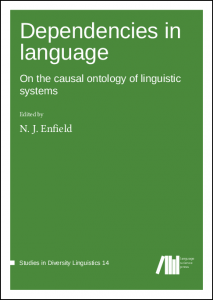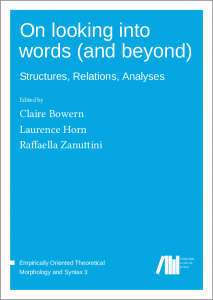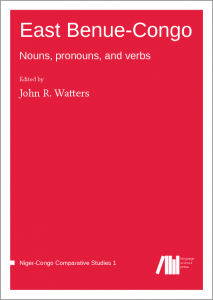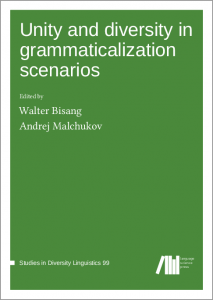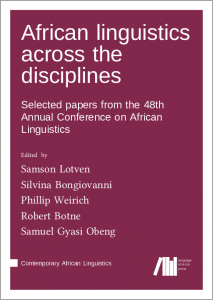Larry, you have authored altogether 7 chapters in 5 LangSci books in 4 different series (see list below). That sounds very versatile! Can you give us some background on those chapters and what ties them together?
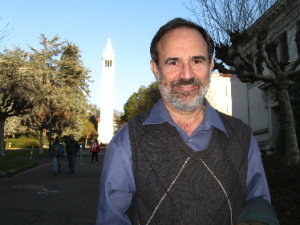 Yes, I guess you could say that my interests are wide-ranging, which I enumerate on the Berkeley Linguistics website as phonological theory, language typology, and African languages, especially Bantu and Niger-Congo. I think what ties them together is that I am always thinking about typology, about how languages are the same vs. different. I’m fascinated with the variation among related languages which respond differently to the same conflicting concerns, often involving interfaces between phonology and grammar. This is the case in my article in the Enfield collection, where I contrasted intra-phonological dependencies with the possibility that there could be non-accidental dependences between phonology, morphology, and syntax. The other six chapters derive from my deep involvement with individual and comparative African linguistics, where I go after whatever strikes me as interesting and important.
Yes, I guess you could say that my interests are wide-ranging, which I enumerate on the Berkeley Linguistics website as phonological theory, language typology, and African languages, especially Bantu and Niger-Congo. I think what ties them together is that I am always thinking about typology, about how languages are the same vs. different. I’m fascinated with the variation among related languages which respond differently to the same conflicting concerns, often involving interfaces between phonology and grammar. This is the case in my article in the Enfield collection, where I contrasted intra-phonological dependencies with the possibility that there could be non-accidental dependences between phonology, morphology, and syntax. The other six chapters derive from my deep involvement with individual and comparative African linguistics, where I go after whatever strikes me as interesting and important.
Given my extensive work on tone systems, it is perhaps surprising that none of the LangSci publications have to do with tone. In more than one occasion I have set out to work on a new tone system (there’s nothing more exciting than studying a language from scratch!), but I quickly am distracted by something unusual and hence intriguing in the grammar. This is the case, for example, in the joint article on Lusoga multiple exponence. The three comparative chapters in the Watters volume as well as the multiple argument chapter in Bisang & Malchukov synthesize my personal field work on several dozen Bantoid, especially Grassfields Bantu languages, in Cameroon, where I could not help becoming involved in reconstructing proto systems as well as the historical developments our Grassfields Bantu Working Group documented language to language, dialect to dialect.
When I told you that you were the most prolific LangSci author, you were surprised. How did you end up with this many different contributions? What were your motivations?
Yes, I was surprised because I thought that others like Martin Haspelmath would have more publications with the press! I think that some of the reason why I have so many publications is because LangSci lends itself to the kind of typological, descriptive, and comparative work I do. In this I join my many colleagues who seek to produce open-access publications whenever possible. Since I was not the editor of any of the five collections, I can’t take credit for the ultimate decision to publish with LangSci, but I am delighted that so many of my publications have appeared with the press.
Is there anything you find particular about the LangSci publication process, either in one particular series or across series? Maybe compared to other works of your nearly 5 decades of publishing experience?
I really like going to the web page and browsing through so many fantastic (and colorful) publications—I think more than any other publisher in fact. A lot is because LangSci series deal so directly with LANGUAGES, that so many of the authors are specialists of languages. I can’t help visiting the web page without downloading something—even if I know that I won’t get to it for some time, I just have to have it!
Next to being an author, you are also a series editor for Niger-Congo Comparative Studies, where the first two books have just been published. Can you tell us a bit more about this series? Any other upcoming projects there?
Yes, this has also been very rewarding, as we are seeing important books appear on Niger-Congo, the largest linguistic stock with over 1500 languages. The Watters collection on the huge Benue-Congo branch (which includes Bantoid and Bantu) was originally planned to cover much more, but there was such a response that it was divided into two (East and West). In producing this series we have been fortunate to be guided by Valentin Vydrin whose ambitious goals are contagious. And how could one not be overwhelmed by Konstantin Pozdniakov’s coverage of Niger-Congo numerals systems!? Thanks to LangSci we can expect more exciting volumes in the near future. Maybe we can attract the proceedings of the five-day International Conference on Reconstructing Bantu Grammar which just took place in Ghent. It was great!
Last question: linguistics is doing rather well in the domain of Open Access as far as the humanities are concerned. We have Language Science Press, we have Glossa, and we have various open database projects like WALS. Any ideas why this works so well in linguistics? What could other disciplines do to emulate this?
I don’t know if I’m in a position to explain this, as I don’t know other disciplines so well, but it’s obvious we need each other and each other’s work in a very major way. Almost from the beginning of the field, linguists have enjoyed extensive interaction, sharing our ideas and our work. When someone has accomplished something not only do they want to share it as widely as possible, but others count on it. In the early generative period, prepublished papers were dittoed or photocopied and circulated by surface mail; today such drafts are posted on a website. This can be something big like a new theory, a phylogenetic classification, or an open database—or it can be something “small” like a newly proposed Bantu reconstruction. There’s always someone who wants to know, and there are always others who have a different opinion (just get on the LINGTYP exchange circuit and you’ll see!). Open-access is thus a logical extension of how we have always operated. Is it not like this in other fields?
Thanks for pointing out the special distinction which has allowed me to express the support that I feel for LangSci. Yes, I was surprised, since I don’t usually look for such “distinctions”! As I like to joke: Although I know I haven’t been shy to publish, if I weren’t such a hedonist I would REALLY be productive :-)!
For reference, the chapters are:
- What (else) depends on phonology? In N. J. Enfield (ed.), Dependencies in language: On the causal ontology of linguistic systems (Studies in Diversity Linguistics 14) http://langsci-press.org/catalog/book/96
- Multiple argument marking in Bantoid: From syntheticity to analyticity. In Walter Bisang & Andrej Malchukov (eds.), Unity and diversity in grammaticalization scenarios (Studies in Diversity Linguistics 16) http://langsci-press.org/catalog/book/152
- (with Sharon Inkelas, Fred Jenga) Multiple exponence in the Lusoga verb stem. In Claire Bowern, Laurence Horn & Raffaella Zanuttini (eds.), On looking into words (and beyond): Structures, Relations, Analyses (Empirically Oriented Theoretical Morphology and Syntax 3) http://langsci-press.org/catalog/book/151
- Common Bantoid verb extensions. In John R. Watters (ed.), East Benue-Congo: Nouns, pronouns, and verbs (Niger-Congo Comparative Studies 1) http://langsci-press.org/catalog/book/190
- Third person pronouns in Grassfields Bantu. In John R. Watters (ed.), East Benue-Congo: Nouns, pronouns, and verbs (Niger-Congo Comparative Studies 1) http://langsci-press.org/catalog/book/190
- More reflections on the nasal classes in Bantu. In John R. Watters (ed.), East Benue-Congo: Nouns, pronouns, and verbs (Niger-Congo Comparative Studies 1) http://langsci-press.org/catalog/book/190
- [to appear] (with Florian Lionnet & Christophère Ngolele) Number and animacy in the Teke noun class system. In Samson Lotven, Silvina Bongiovanni, Phillip Weirich, Robert Botne & Samuel Gyasi Obeng (eds.), African linguistics across the disciplines: Selected papers from the 48th Annual Conference on African Linguistics (Contemporary African Linguistics 5) http://langsci-press.org/catalog/book/226

